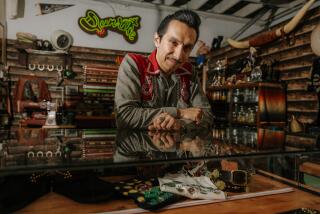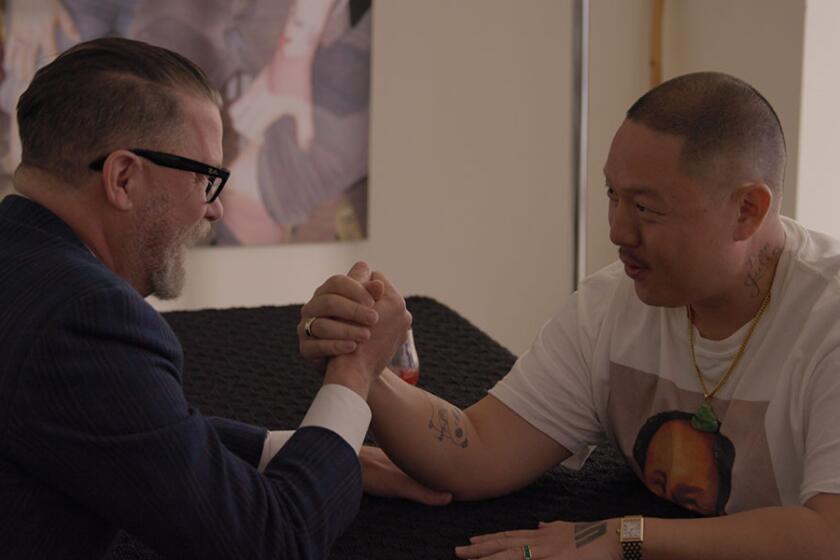Who made Eddie Murphy’s ‘Dolemite Is My Name’ ’70s costumes? ‘Black Panther’ Oscar-winner Ruth Carter
When Oscar-winning costume designer Ruth E. Carter signed on to outfit the stars of Netflix’s upcoming dramedy “Dolemite Is My Name,” she did it with the caveat that the costumes themselves wouldn’t serve as just another punchline in the story.
“This is not a film where you make fun of everybody and you laugh because everybody’s got a big Afro and bell-bottoms,” she said. “This is a film where you look a little bit deeper into all of the details about this time and you make people look good.”
The film stars Eddie Murphy as Rudy Ray Moore, a floundering comedian determined to claw his way into the spotlight. He manages to do just that by creating the alter ego Dolemite, an obscene pimp caricature borrowed from the street mythology of 1970s Los Angeles.
With Dolemite, Moore quickly transitions from disgruntled record store employee to stage act to purveyor of his own illicit comedy albums before eventually becoming a movie star against all odds. Comedians Keegan-Michael Key, Mike Epps, Craig Robinson, Tituss Burgess and Da’Vine Joy Randolph round out the cast, along with a memorable comedic turn by Wesley Snipes. The film, which world premieres at the Toronto International Film Festival next month, will hit theaters Oct. 4 and Netflix streaming on Oct. 25.
Though Carter (who won an Oscar last year for her work on “Black Panther”) has crafted period costumes for almost a dozen films — including the ’70s-specific movies “Crooklyn” (1994) and “What’s Love Got to Do With It” (1993) — the wardrobe for “Dolemite” was more exaggerated and over-the-top than anything she’s constructed since 2009’s blaxploitation parody “Black Dynamite.”
“I wanted to really show the ’70s fashion that I knew and remembered and that people loved,” she said. “The urban fashion kind of created its own look. There were the hippies with their earth shoes and fringe vests or you could be urban and do that kind of pimp, prostitute look.”
Carter drew inspiration for costumes directly from Moore’s own films, leaning heavily on his 1975 feature debut “Dolemite” whose slapdash production is illustrated in the Netflix film.
“I noticed all of the costume changes that he had, and had an illustrator sit down and look at every angle of the costumes and illustrate them,” said Carter. “That took some time.”
She also referenced her vast stores of ’70s fashion magazines including Ebony, Esquire and the now-defunct Eleganza catalog.
“Richard Roundtree, who plays ‘Shaft,’ was a fashion model at the time for the magazine,” Carter recalled. “It showed the urban fashions which, in many ways, mimicked the blaxploitation era of pimp culture: the maxi coats with the fur collar, the homburg, polyester double knit jumpsuits, matador pants, marshmallow shoes. I remember as a kid how people would love to look at that magazine and just dream about ordering some of that stuff.”
Dolemite/Rudy Ray Moore was so interesting in his costume choices that we tried to do it exactly the way he did it so we had to build everything.
— Ruth Carter
With just six weeks of prep, Carter had to work fast. After gathering reference points, her first order of business was to source costumes and fabrics from costumers across Los Angeles to outfit the seven stars of the film. Murphy’s character alone required between 35 and 40 different costumes.
“And all of it was custom made because it’s really hard to [find] ’70s vintage and make it really look like Dolemite,” she said. “Dolemite/Rudy Ray Moore was so interesting in his costume choices that we tried to do it exactly the way he did it so we had to build everything.”
Rather than hunting down ready-made ’70s-style costumes, Carter opted instead to procure authentic fabrics and materials from the decade to make her own.
“I went to a fabric store that had fabrics that were never bought from the ’70s and ’80s and collected double knit polyester, that particular style of denim and all of those interesting combinations of pastel, plaid and wovens and [supplemented them with] the shelves and shelves of ’70s fabrics I just had in my studio,” she said.

Distinguishing Rudy Ray Moore’s style from his alter ego Dolemite’s required Carter to flesh out separate aesthetics for the two different personas. “There were two characters that were kind of happening simultaneously,” said Carter. “Sometimes [Moore] went to meetings and interviews dressed as Dolemite and other times, especially in the beginning, he was just Rudy.”
While Moore’s style was already distinctive, Dolemite’s pimp culture-inspired wardrobe was outré even by ’70s standards.
“Even though the ’70s was pretty out there, Dolemite took it to another level,” Carter said. “So I had to create this unique style that felt even more outrageous than the ’70s was already. I was very conscious of that in the character patterns that I picked. They weren’t necessarily something that you would see on the street because he was creating a very distinct character so I had to make the costumes look very unique. And unique for the ’70s is not easy.”
Besides dressing Moore’s troupe of fellow comedians, Carter was also tasked with dressing the white UCLA students that helped produce “Dolomite,” whose outfits reflected the separate microcosm of the ’70s that they operated in.
“Everybody had their thing in the ’70s,” she said. “When you think to what was popular among black culture it was [1973’s] ‘The Mack’ and John Shaft [of 1971’s ‘Shaft’] and so the black community emulated a lot of the looks in those films. And white people for the most part were into other aspects of the ’70s.
“If you think about what was considered the straight-laced look, even the conservatives had elements of the ’70s where the collar and the lapel was a little bit bigger,” she added. “And then there were the hippies, the UCLA students that listened to Carly Simon and the Beatles with their hip-hugger jeans and denim vests and tube tops. We had clear definitions in the ’70s, it wasn’t as culturally immersive as it is now. Whites had their look divided between hippies, Hollywood and the conservative and blacks had their look and it was divided between following the blaxploitation look and being more Ebony magazine, wanting to look opulent and upper middle class. So I just tried to key into that and be as authentic as I could to those definitions.”
After working with Murphy a handful of times on films like “Daddy Day Care,” “Meet Dave,” “Dr. Dolittle 2” “Imagine That” and in the upcoming “Coming 2 America,” the veteran comedian and veteran costumer have honed a creative shorthand that makes collaborating seamless.
“I’ve always understood that he as a performer is a transformationist,” said Carter. “He would be very reliant on me to do my work in that I could not disrupt his process. He doesn’t dispute the costume though I’ve always let him know what my plans are and show him illustrations. And so with that understanding, we go through a process where he’s working on portraying a character and I’m doing the same but with clothing. I cannot disrupt his process by making things encumbered, making him uncomfortable. I have to keep his process and mine fluid. So that’s what I focus on, how do we bridge the gap between function and then the look.”
In addition to being familiar with each other’s creative processes, Murphy and Carter also benefited from having similar memories of the ’70s.
Character studies like “Joker,” sequels like “It Chapter Two” and “Terminator: Dark Fate” and the return of “Downton Abbey” are just a few of the films slated to be released this fall that we explore in our Fall Movie Sneaks.
“I think because Eddie and I are about the same age we remember the ’70s the same way,” Carter said. “I gave him a pair of shoes and they’re called marshmallows, they’re platform shoes that had a white heel and a white platform that was usually like a spongy material. And he’s like ‘Oh, yeah, I remember marshmallows. I had a pair.”
Despite his familiarity with the style, getting Murphy back into a pair of the heeled shoes presented its own unique challenge.
“Dolemite wasn’t doing like an Elton John platform, he had more of a sneaker look to his platforms so I had all of those shoes custom made,” Carter recalled. “And we’re not 16 or 25 anymore, so putting Eddie, who’s in his 50s, in platform shoes and having him be in them all day was not an easy feat literally or figuratively. I remade them several ways to try to make them more comfortable. When he stopped complaining about his feet hurting is when I finally made a pair of platform shoes out of an Adidas sneaker.” She laughs. “And then he was comfortable.”
More to Read
Only good movies
Get the Indie Focus newsletter, Mark Olsen's weekly guide to the world of cinema.
You may occasionally receive promotional content from the Los Angeles Times.











